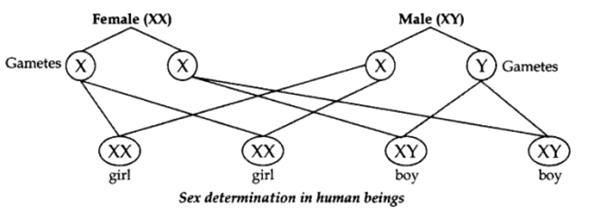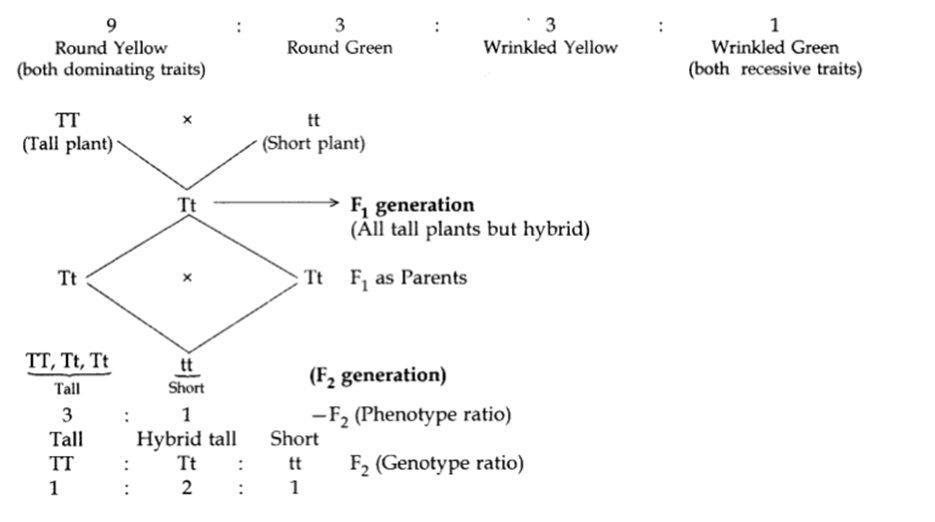CBSE Class 10 Science Chapter 9 Heredity and Evolution Important 1,2,3 and 5 Markers Questions with Answers
Heredity and Evolution Important Questions – Here are the Important questions (1,2,3 and 5 Markers) for CBSE Class 10 Science Chapter 5 Periodic Classification of Elements. The important questions we have compiled will help the students to brush up on their knowledge about the subject. Students can practice Class 10 Science important questions to understand the subject better and improve their performance in the board exam. The solutions provided here will also give students an idea about how to write the answers. Take Free Online MCQ Test for Class 10
Class 10 Science Chapter 9 Heredity and Evolution MCQs 1 Marks
Q 1. Human teeth and elephant’s tusk are
(a) Analogous organs
(b) Vestigeal organs
(c) Homologous organs
(d) Rudimentary organs
Answer – (c) Homologous organs
Q 2. A trait in an organism is influenced by
(a) Paternal DNA only
(b) Maternal DNA only
(c) Both maternal and paternal DNA
(d) Neither by paternal nor by maternal DNA
Answer – (c) Both maternal and paternal DNA
Q 3. According to the evolutionary theory, the formation of a new species is generally due to
(a) Sudden creation by nature
(b) Accumulation of variations over several generations
(c) Clones formed during asexual reproduction
(d) Movement of individuals from one habitat to another
Answer – (b) Accumulation of variations over several generations
Q 4. A zygote which has an X-chromosome inherited from the father will develop into a
(a) Boy
(b) Girl
(c) X- chromosome does not determine the sex of a child
(d) Either boy or girl
Answer – (b) Girl
Q 5. Select the group which shares maximum number of common characters.
(a) Two individuals of a species
(b) Two species of a genus
(c) Two genera of a family
(d) Two genera of two families
Answer – (a) Two individuals of a species
Heredity and Evolution Related Links –
Class 10 Science Chapter 9 Heredity and Evolution Very Short Answer
Q1. What is DNA?
Answer – DNA. Deoxyribonucleic acid is a genetic material found in all the living organisms.
It is the carrier of hereditary information from parents to the next generation.
Q2. No two individuals are absolutely alike in a population. Why?
Answer – DNA copying is an essential part of the process of reproduction for the inheritance of features from parents to the next generation. The process of DNA copying brings some variation each time.
The surviving cells are similar to but subtly different from each other. This in built tendency for variation during reproduction brings variations among individuals of the same species. Thus, no two individuals are absolutely alike in a population.
Class 10 Science Chapter 9 Heredity and Evolution Short Answer Type
Q3. State the importance of chromosomal difference between sperms and eggs of humans.
Answer – A male has one X chromosome and one Y chromosome. Thus half the sperms will have X chromosomes and the other half will have Y chromosome.
A female has two X chromosomes. So all the female gametes will have only X chromosomes.
If a sperm carrying X chromosome fertilizes an ovum then the child born will be a girl. If a sperm carrying Y chromosome fertilizes an ovum then the child born will be a boy.
Thus the chromosomal difference between sperms and eggs of humans determines the sex of the child.
Class 10 Science Chapter 9 Heredity and Evolution Short Answer Type
Q4. Define homologous and analogous organs.
Classify the following as homologous or analogous organs:
(i) Wings of an insect and wings of bat.
(ii) Forelimbs of a man and forelimbs of a frog.
Answer – Homologous Organs: Those organs which have the same basic structure or same basic design but different functions, are called homologous organs.
Analogous Organs: Those organs which have different basic structure or different basic design but have similar appearance and perform similar functions are called analogous organs.
- These are analogous organs.
- These are homologous organs.
Important Videos Links
Q5. Explain the terms:
(i) Speciation;
(ii) Natural selection.
Answer – (i) Speciation: The process by which new species develop from the existing species is known as speciation. The important factors which could lead to the formation of new species are:
Geographical isolation of a population caused by various types of barriers like mountain ranges, rivers, sea etc. The geographical isolation leads to reproductive isolation due to which there is no flow of genes between separated groups of population.
Genetic drift caused by drastic changes in the frequencies of particular genes by chance alone.
Variations caused in individuals due to natural selection.
(ii) Natural Selection: Natural selection is the process of evolution of a species whereby characteristics which help individual organisms to survive and reproduce are passed on to their offsprings and those characteristics which do not help are not passed on.
Q6. (a) “The sex of the children is determined by what they inherit from their father and not their mother.” Justify.
(b) Give an example where environmental factors like temperature determines the sex of the offspring.
Answer – (a) A male has one X chromosome and one Y chromosome.
A female has two X chromosomes.
If a sperm carrying X chromosome fertilises an ovum, then the child bom will be a girl.
If a sperm carrying Y chromosome fertilises an ovum, then the child born will be a boy.
Thus, the sperm determines the sex of the child.
(b) In some reptiles, the temperature at which the fertilised egg is incubated before hatching plays a role in determining the sex of the offspring.
Example: In a turtle, high incubation temperature leads to female offspring.
Q7. What is meant by the term speciation? List four factors which could lead to speciation.
Answer – The process by which new species develop from the existing species is known as speciation. Important factors which could lead to the formation of a new species are as follows:
Genetic drift caused by drastic changes in the frequencies of particular genes by chance alone.
Geographical isolation of a population caused by various types of barriers like mountain ranges, river, sea etc. The geographical isolation leads to reproductive isolation due to which there is no flow of genes between separated groups of population.
Variation caused in individuals due to natural selection.
Sometimes the sub-population becomes reproductively isolated by ecological barriers. Therefore it occurs within the same geographical area and within the original population.
Q8.“The father is responsible for the sex of a child, not the mother.” Justify this statement.
Answer – A male has one X-chromosome and one Y-chromosome. Thus half the male gametes have X- chromosomes and the other half have Y-chromosomes.

If a sperm carrying Y-chromosome fertilises an ovum carrying X-chromosome, then the child born will be a boy.
If a sperm carrying X-chromosome fertilises an ovum carrying X-chromosome, then the child born will be a girl.
Therefore it is the sperm from the father which determines the sex of the child.

Q9. A cross was carried out between a pure bred tall pea plant and a pure bred dwarf pea plant and F1 progeny was obtained. Later, the F1 progeny was selfed to obtain F2 progeny. Answer the following questions:
(a) What is the phenotype of the F1 progeny and why?
(b) Give the phenotypic ratio of the F2 progeny.
(c) Why is the F2 progeny different from the F1 progeny?
Answer – When plants of two different traits of character are crossbred to get a progeny (F1 generation), only the dominant trait is visible in this generation. But when plants of F1 generation are selfbred then the two traits of character get separated and the recessive trait also appears in the plant of F2 generation.
This is known as Law of Segregation (separation) of traits.
Flow Chart

Class 10 Science Chapter 9 Heredity and Evolution Long Answer Type
Q1. How do Mendel’s experiments show that the (a) traits may be dominant or recessive, (b) traits are inherited independently?
Answer – (a) Mendel’s experiments show that: In Mendel’s experiment with pea plants,
(b) when he crossbred a pure tall pea plant with a pure dwarf pea plant, he found that the first generationF1 was of only tall plants. Tallness is the dominant trait. Then he produced F2 generation by selfing of hybrids F1
In the F1 progeny, no dwarf plants were obtained. However in F2 generation, both tall and dwarf plants were obtained in the ratio 3 : 2 respectively. The trait which remains hidden in F1 generation, i.e., dwarfness is the recessive trait.
He observed that even when not expressed in the first generation, alternate forms of a trait could retain their identify in the hybrid and could re-emerge in the next generation.
(b) Traits are inherited independently. Mendel cross-bred pea plants showing two different characteristics, rather than just one.
When he crossbred pea plants of round green seeds with wrinkled yellow seeds, he got F1 generation with all such seeds which were yellow and round. So, it was concluded that round and yellow character of seeds were dominant traits in the pea plant. On selfing of F1 progeny, different types of F2 progeny were obtained.
F2 progeny along with their ratios obtained in F2 generation:
So traits of two different characters were inherited independent of each other and made new combination characteristics independent of their previous combinations.

CBSE Class 10 Science Important Questions with Answers